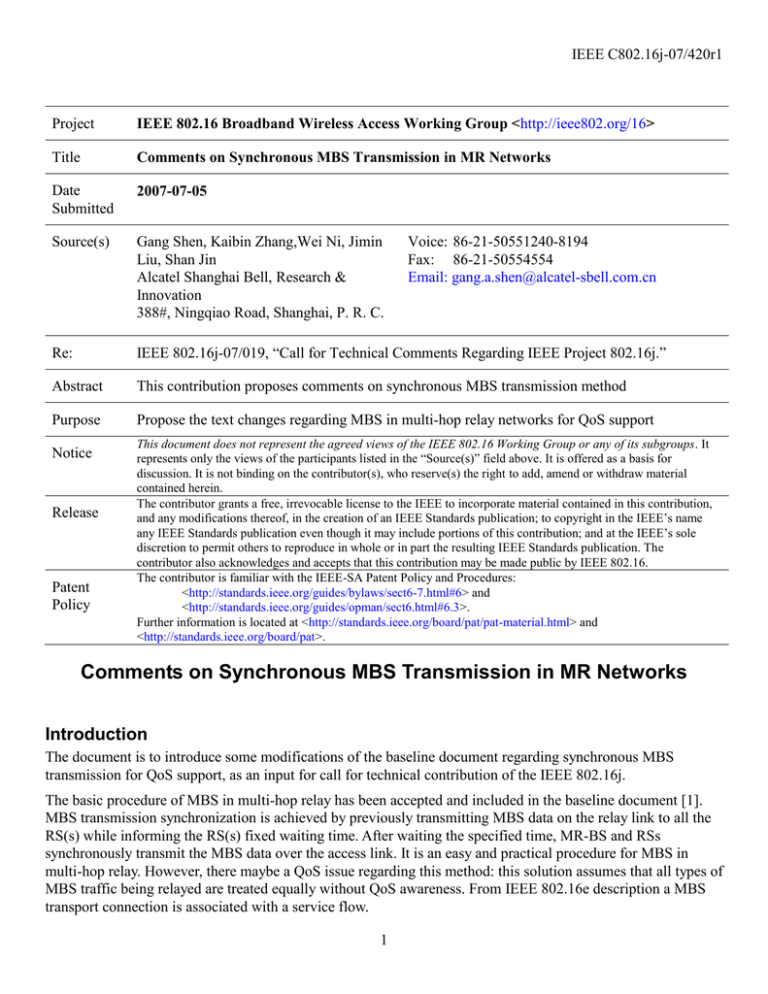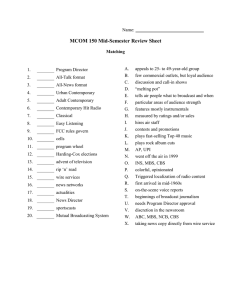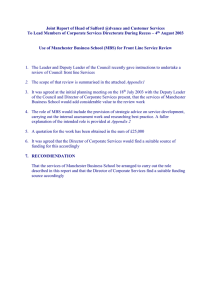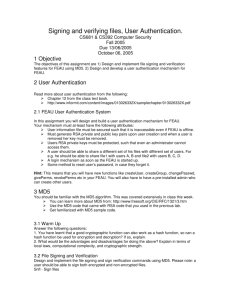IEEE C802.16j-07/420r1 Project Title
advertisement

IEEE C802.16j-07/420r1 Project IEEE 802.16 Broadband Wireless Access Working Group <http://ieee802.org/16> Title Comments on Synchronous MBS Transmission in MR Networks Date Submitted 2007-07-05 Source(s) Gang Shen, Kaibin Zhang,Wei Ni, Jimin Liu, Shan Jin Alcatel Shanghai Bell, Research & Innovation 388#, Ningqiao Road, Shanghai, P. R. C. Re: IEEE 802.16j-07/019, “Call for Technical Comments Regarding IEEE Project 802.16j.” Abstract This contribution proposes comments on synchronous MBS transmission method Purpose Propose the text changes regarding MBS in multi-hop relay networks for QoS support Notice Release Patent Policy Voice: 86-21-50551240-8194 Fax: 86-21-50554554 Email: gang.a.shen@alcatel-sbell.com.cn This document does not represent the agreed views of the IEEE 802.16 Working Group or any of its subgroups. It represents only the views of the participants listed in the “Source(s)” field above. It is offered as a basis for discussion. It is not binding on the contributor(s), who reserve(s) the right to add, amend or withdraw material contained herein. The contributor grants a free, irrevocable license to the IEEE to incorporate material contained in this contribution, and any modifications thereof, in the creation of an IEEE Standards publication; to copyright in the IEEE’s name any IEEE Standards publication even though it may include portions of this contribution; and at the IEEE’s sole discretion to permit others to reproduce in whole or in part the resulting IEEE Standards publication. The contributor also acknowledges and accepts that this contribution may be made public by IEEE 802.16. The contributor is familiar with the IEEE-SA Patent Policy and Procedures: <http://standards.ieee.org/guides/bylaws/sect6-7.html#6> and <http://standards.ieee.org/guides/opman/sect6.html#6.3>. Further information is located at <http://standards.ieee.org/board/pat/pat-material.html> and <http://standards.ieee.org/board/pat>. Comments on Synchronous MBS Transmission in MR Networks Introduction The document is to introduce some modifications of the baseline document regarding synchronous MBS transmission for QoS support, as an input for call for technical contribution of the IEEE 802.16j. The basic procedure of MBS in multi-hop relay has been accepted and included in the baseline document [1]. MBS transmission synchronization is achieved by previously transmitting MBS data on the relay link to all the RS(s) while informing the RS(s) fixed waiting time. After waiting the specified time, MR-BS and RSs synchronously transmit the MBS data over the access link. It is an easy and practical procedure for MBS in multi-hop relay. However, there maybe a QoS issue regarding this method: this solution assumes that all types of MBS traffic being relayed are treated equally without QoS awareness. From IEEE 802.16e description a MBS transport connection is associated with a service flow. 1 IEEE C802.16j-07/420r1 The MBS method in this proposal has a little modification of the baseline document to achieve MBS QoS awareness support with more flexibility. The proposed modification supports MBS data synchronization by associating waiting time with connections. The QoS-aware approach is consistent with mechanisms already provided by 802.16e. Proposed Solution This proposal gives some modifications of synchronous MBS transmission in multi-hop relay for QoS support as optional case. As defined in IEEE 802.16j-06/026r4, MR-BS needs to know the maximum required waiting delay for MBS traffic delivered to each RS. The value of this delay will be reported to the MR-BS through management messages. MR-BS determines cumulative delay based on information received from RS and scheduling information. When MBS data is scheduled, the maximum transit delays to all access RSs are determined by the MR-BS, while the maximum transit delay should reflect the QoS level associated with different MBS CID. In other words, different MBS connections may have different values of maximum transit delay in one MR cell. The MR-BS shall then calculate the required waiting time for each connection in each RS based on the value of cumulative delay and processing time reported by RS. For a given RS, MR-BS configures different waiting delays for different MBS connection. High priority MBS connections are configured with short waiting delays. Low priority MBS ones are configured with long transit delay to let limited bandwidth firstly served to other time-constraint services. An example is illustrated in Fig. 1, there are two MBSs with CID1 and CID2, where the first one has higher QoS priority. In the case of limited bandwidth, MR-BS allocates resource for the MBS with CID1 firstly with short waiting time configured. In comparison, the MBS traffic with CID2 is configured with a longer waiting time in RS. RS may receive MBS data within one frame, however re-transmits different MBS data at different frames. 2 IEEE C802.16j-07/420r1 RS MR-BS MS Report processing delay Inform RS the set of waiting times corresponding to different MBS connections MR-RS calculates waiting times for different MBS connections MBS traffic pre-transmission to RS (MBS CID1 & CID2 with different QoS) Waiting Time 1 Waiting Time 2 Simultaneous MBS traffic with CID1 (high priority) by RS and MR-BS Simultaneous MBS traffic with CID2 (low priority) by RS and MR-BS Fig.1 Procedures of Synchronized MBS for Multi-hop Relaying MR-BS also knows the traffic status information for each RS. Based on its knowledge, MR-BS may adaptively adjust the waiting time for each connection in different RS. How to collect the traffic status information is outside the scope of this contribution. This document proposes a synchronized QoS-aware MBS scheme for multi-hop relay. It associates RS waiting time with MBS connection, and thus provides QoS support for MBS transmission. It can be taken as optional complementarities to existing MBS transmission. Proposed Text Changes [Modify text in section 6.3.23.3:] For MR networks, MBS transmission within an MBS zone shall be synchronized. In Multi-MR-BS-MBS case, MR-BSs should be synchronized in network level as described in section 6.3.23.2. If there is only one RS connecting with the MR-BS, that RS shall report its processing delay (in units of a frame), DR to the MR-BS as a capability parameter in the SBC-REQ message. Optionally, the MR-BS may determine the waiting delay, DR+Dj (Di 0)for each connection based on their service level. When an MBS transmission is necessary, the MR-BS shall first send the MBS data over the relay downlink as a pretransmission, and then after DR frames or optionally after DR+Dj (Di 0) frames regarding different connections, the MR-BS and RS shall synchronously transmit this MBS data over the access link. If there are multiple RSs in the MBS zone at various hop counts from the MR-BS and/or with different 3 IEEE C802.16j-07/420r1 processing delays, each RS shall report its processing delay, DR, to the MR-BS as a capability parameter in the SBC-REQ message. The MR-BS shall determine the maximum cumulative delay, DM, of all RSs in the MBS zone based on their positions in the tree and their individual processing delays. The MR-BS shall then calculate the required waiting time, Wi, for each RS based on the value of DM and each RS’s cumulative delay and notify each RS of its waiting time via an SBC-RSP message. If the MR-BS detects that the waiting time has changed for a particular RS, it may send an unsolicited SBC-RSP message to that RS to update its waiting time. Optionally, the MR-BS may determine the maximum cumulative delays, DM, of all RSs in the MBS zone for each connection based on their service levels, as well as their positions in the tree and their individual processing delays. The MR-BS shall then calculate the required waiting time, Wi, for each connection in different RS based on the value of DM and each RS’s cumulative delay and notify each RS of its waiting time, as well as corresponding connection via an SBC-RSP message. When an MBS transmission is necessary, the MR-BS shall forward the MBS data over the relay downlink as a pre-transmission DM frames before transmitting this MBS data over the access link. Each RS in the MBS M zone shall forward the MBS data it receives over the relay downlink. Finally, once the MR-BS has waited DM frames and each RS has waited its specified waiting time, Wi, the MR-BS and RSs shall synchronously transmit the MBS data over the access link. [Insert the subclause as follows] 11.8.3.7.X RS waiting time for MBS Type TBA Length variable Value Scope SBC-RSP Compound These TLV values shall appear in each above TLV Type TBA.1 TBA.2 Length 2 1 Value CID RS waiting time regarding connection Reference [1] P802.16j Baseline Document (IEEE 802.16j-06/026r4) 4




